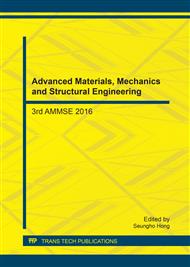[1]
W. Caseri, Nanocomposites of polymers and metals or semiconductors: historical background and optical properties, Macromol. Rapid Commun. 21 (2000) 705-722.
DOI: 10.1002/1521-3927(20000701)21:11<705::aid-marc705>3.0.co;2-3
Google Scholar
[2]
J. Yue, V. Sankaran, R. E. Cohen, R. R. Schrock, Interconversion of ZnF2 and ZnS nanoclusters within spherical microdomains in block copolymer films, J. Am. Chem. Soc. 115 (1993) 4409-4444.
DOI: 10.1021/ja00063a088
Google Scholar
[3]
J. Belloni, M. Mostafavi, H. Remita, J. L. Marignier, M. O. Delcourt, Radiation-induced synthesis of mono-and multi-metallic clusters and nanocolloids, New J. Chem. 22 (1998) 1239-1255.
DOI: 10.1039/a801445k
Google Scholar
[4]
A. R. Khokhlov, On the collapse of weakly charged polyelectrolytes, J. Phys. A: Math. Gen. 13 (1980) 979-987.
DOI: 10.1088/0305-4470/13/3/030
Google Scholar
[5]
K. Malick, M. J. Witcomb, M. S. Scurrell, Polymer stabilized silver nanoparticles: a photochemical synthesis route, J. Mater. Sci. I. 39 (2004) 4459-4463.
DOI: 10.1023/b:jmsc.0000034138.80116.50
Google Scholar
[6]
L. J. P. Trinidad, K. A. S. Usman, L. M. Jr. Payawan, γ-Irradiation Induced Synthesis of Titanium Dioxide/Poly (acrylic acid)(TiO2/PAA) Nanocomposites and Layer-by-Layer Assembly on Glass Substrate, Adv. Mater. Res. 1098 (2015).
DOI: 10.4028/www.scientific.net/amr.1098.25
Google Scholar
[7]
M. Keshmiri, T. Troczynski, Synthesis of narrow size distribution sub-micron TiO2 spheres, J. Non-Crystalline Solids, 311 (2002) 89-92.
DOI: 10.1016/s0022-3093(02)01607-1
Google Scholar
[8]
S. Liufu, H. Xiao, Y. Li, Adsorption of poly (acrylic acid) onto the surface of titanium dioxide and the colloidal stability of aqueous suspension, J. Coll. Interf. Sci. 281 (2005) 155-163.
DOI: 10.1016/j.jcis.2004.08.075
Google Scholar
[9]
R. A. McAloney, M. Sinyor, V. Dudnik, M. C. Goh, Atomic force microscopy studies of salt effects on polyelectrolyte multilayer film morphology, Langmuir, 17 (2001) 6655-6663.
DOI: 10.1021/la010136q
Google Scholar
[10]
S. Chibowski, M. Wisniewska, A. W. Marczewski, S. Pikus, Application of the SAXS method and viscometry for determination of the thickness of adsorbed polymer layers at the ZrO 2–polymer solution interface, J. Coll. Interf. Sci. 267 (2003) 1-8.
DOI: 10.1016/s0021-9797(03)00698-2
Google Scholar
[11]
R. Silveyra, L. De La Torre Saenz, W. A. Flores, V. C. Martinez, A. A. Elguezabal, Doping of TiO 2 with nitrogen to modify the interval of photocatalytic activation towards visible radiation, Catal. Today, 107-108 (2005) 602-605.
DOI: 10.1016/j.cattod.2005.07.023
Google Scholar
[12]
A. Foissy, A. El Attar, J. M. Lamarche, Adsorption of polyacrylic acid on titanium dioxide, J. Coll. Interf. Sci. 96(1) (1983) 275-287.
DOI: 10.1016/0021-9797(83)90029-2
Google Scholar
[13]
K. A. S. Usman, L. J. P. Trinidad, L. M. Jr. Payawan, UV-Irradiation Induced Synthesis of Fluorescent Poly (Acrylic Acid) Stabilized Silver Clusters, MATEC Web of Conferences, Vol. 27. EDP Sciences, (2015).
DOI: 10.1051/matecconf/20152701007
Google Scholar
[14]
M. T. C. Sansiviero, D. S. dos Santos, A. D. Job, R. F. Aroca, Layer by layer TiO 2 thin films and photodegradation of Congo red, J. Photochem. Photobiol. A: Chem. 220 (2011) 20-24.
DOI: 10.1016/j.jphotochem.2011.03.007
Google Scholar
[15]
H. G. Pedersen, L. Bergström, Forces measured between zirconia surfaces in poly (acrylic acid) solutions, J. Am. Ceram. Soc. 82 (1999) 1137-1145.
DOI: 10.1111/j.1151-2916.1999.tb01887.x
Google Scholar


